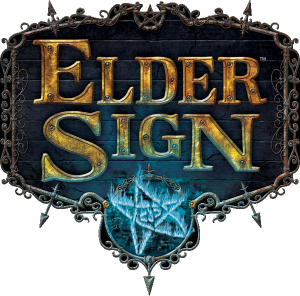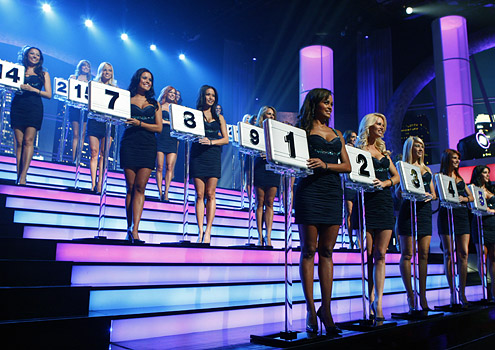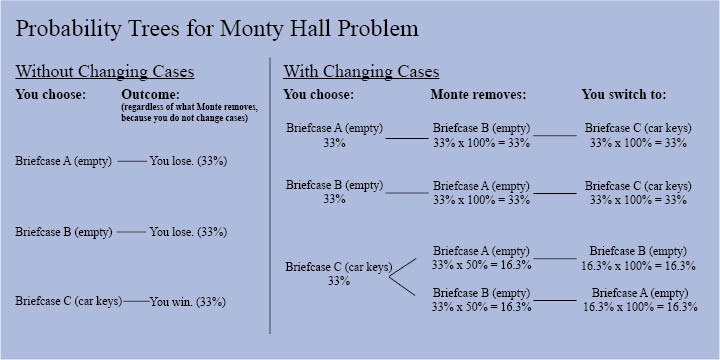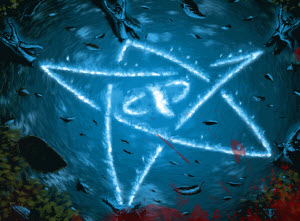I’ve been playing a lot of Elder Sign lately because (a) it’s a great game, and (b) it’s one of the few really good, relatively quick co-op games I know (having played Pandemic just about into the ground over the past two years). In my most recent game, we were, as one always is in Elder Sign, struggling against the forces of ancient madness both in the story of the game and in its playing.
 If you haven’t tried it, the basic mechanic of Elder Sign is that you have to make certain rolls to complete certain adventures – and once you’ve rolled what you need, you have to set those dice aside for subsequent rolls on the adventure.
If you haven’t tried it, the basic mechanic of Elder Sign is that you have to make certain rolls to complete certain adventures – and once you’ve rolled what you need, you have to set those dice aside for subsequent rolls on the adventure.
If you have played it, you’ll know what it’s like to look at an adventure, think, “Three skulls and two scrolls? Yeah, no problem,” and then find, two rolls in, that it’s literally impossible for you to complete the adventure. During the last game session I played, a few players had to explain to another player why, without any clue tokens or bonus dice, it was unlikely that he’d be able to complete an adventure requiring six specific die faces.
I don’t think that we, as humans, are wired to think in terms of probability, and if we are, we really ought to be rewired. In fact, I think we’re wired to think that the odds are ever in our favor, even when they’re clearly not. Evolutionarily, you don’t make it out of the jungle without taking some chances; if our ancestors really thought about it, they would have never tried to drop the first woolly mammoth. Or the last one, for that matter. But still, we owe our continued existence as a species to the first dudes who decided to chuck a pointy stick at a mammoth.
At the same time, I think it’s easy to underestimate odds of success, especially when the “locked die” mechanic comes into play, whether that’s locking a successful die in or losing one when you don’t make a roll. I love the mechanic because it complicates things so much. Not only is the probability of success different now, you’ve got one fewer dice in the pool. If you’re after multiple combinations, you can really screw yourself over. It’s a risk, and one that is very difficult to calculate. Trust me: I’ve been trying for the past five hours to come up with a spreadsheet to do it.
The Monty Hall Scenario
To illustrate that people aren’t inherently good at calculating even basic odds, let’s take the “Monty Hall” problem. It behaves like this: you’re on a game show, and you’re told that there are keys to a car in one of three briefcases in front of you. If you open the correct briefcase, you’ll win a new car. If you one of the two empty briefcases, you’ll get nothing. You’ll lose, good day, sir.
You look over briefcases A, B & C, and you select Briefcase A. Just as you’re about to open it up, your host Monty Hall says, “Hold on a second! We’re going to give you a chance to change your mind. I know what’s in the briefcases, and I’m going to take away one briefcase with nothing in it.” He opens up Briefcase B to show you that it’s empty. “Now,” he says, “you can either keep Briefcase A, or you can switch to Briefcase C. Would you like to swap briefcases?”
The answer is an emphatic yes.
In fact, you’ll be twice as likely to get the car if you switch. Keeping your result means that you have a 1 in 3 chance of getting the car; switching your choice means that you’ll have a 2 in 3 chance of getting the car.
If this is the first time you’re seeing this problem, I know what you’re going through. I went through it three years ago when I first saw the problem, so stay with me. How could this possibly work? After all, it seems like, given the choice between two options where only one is right, you have a 1 in 2 chance of being correct…
Here’s how it works. When you first make a selection, there are three options: you have a 1 in 3 chance of picking the car right off and a 2 in 3 chance of picking nothing. So, two out of three times, you’ll take a case with nothing in it. Once you’ve picked, Monty Hall removes one wrong answer. This means that if you chose an empty case initially (and, remember, there was a 2 in 3 chance of that), by changing briefcases you’ll be choosing the one with the keys now – because there’s a 2 in 3 chance that the one you’re currently holding is the other empty briefcase.
Of course, if you chose the one with the keys in it first (a 1 in 3 chance), by switching you’ll be choosing an empty briefcase now, which would really be a bummer, but, hey, odds are odds. In effect, switching allows you to reverse whether your first choice was right or wrong. It gives you a 2 in 3 chance of winning a car.
So, you switch to Briefcase C, and, 2 out of 3 times, you just won a new car. And if you don’t believe me, check out the diagram below, showing two probability trees indicating what happens if you switch and if you don’t:
A moment of historical interest about this scenario: This problem gained fame when Marilyn vos Savant, in her column “Ask Marilyn,” published the problem and stated that the best choice is to switch choices once one wrong answer is taken away. She got thousands of angry letters from readers, many of them PhDs, criticizing her for promoting mathematical idiocy. So, if you’re having trouble with this one, you’re not alone. But, the answer is clear: you should switch briefcases.
Playing the Odds
Even though we’re so probabilistically-challenged as a species – or maybe because we’re so deficient in that respect – I think anyone working on game design needs to think carefully about the odds in their game. Since most games involve probability, and you’re technically reading an article about game design, this means you.
Probability is an often-overlooked element of mechanics. Early playtests often reveal that some elements of gameplay are much more likely than the creator originally intended – or much, much less likely. Sure, one can go with the old ‘let’s see how this works out’ approach and playtest without thinking about probability first, but, having been on both sides of playtesting quite a few times, I can tell you: your friends want to play as polished a game as possible – and you’re more likely to keep them playtesting your games.
So what do we have to keep in mind when it comes to probability? I propose three things:
Step One
 Know that very, very few people can do complex probability calculations in their heads (or even on paper), so any mechanics that rely on very, very complex probability are probably not the best ones to use.
Know that very, very few people can do complex probability calculations in their heads (or even on paper), so any mechanics that rely on very, very complex probability are probably not the best ones to use.
Instead, I think a great example of a game that uses a highly intuitive element of probability is Settlers of Catan. Everyone knows that the 6’s and 8’s are much more likely to come up, so you try to put your settlements there. The odds of different 2d6 totals are quite straightforward and follow a nice, even pattern out from 7.
On the other hand, if you do use counterintuitive elements of probability in your game, know that it’s going to be an area that frustrates most players and puts some of them at a disadvantage over people who have an understanding of it. (I’m looking at you, Elder Sign – but I still love you.)
And if you put something like the Monty Hall problem in your game – itself not terribly complex, just super counterintuitive – chances are, players are going to get it wrong.
Step Two
Make sure that you aren’t making things that are profoundly improbable have to happen in a game. If you do, you should know that they’re profoundly improbable. While gamers love a good challenge, doing the nearly impossible is, not surprisingly, nearly impossible. There’s very little fun in rerolling a d20 twenty three times to try for a natural 20.
At the same time, if you’re going to have less likely outcomes, players need to be able to avoid those and/or have greater rewards for reaching those outcomes. Elder Sign does a nice job of both of these by allowing players to choose from at least six adventures and by awarding more points and more loot for the less probable ones to succeed at.
Additionally, having nearly impossible events to achieve are going to frustrate players no matter how highly they’re rewarded might not be a great idea. People don’t always know how little the odds favor them, especially when they’re blinded by the possible outcome (I call this “punching the mammoth”).
Step Three
Finally, and most importantly, having a basic understanding of probability is critical for any game designer. I’m not talking about sitting down and working out the number of permutations that would lead to having at least three of the same suit in your hand if you have a six suit deck (though if you’re like me, that sounds like a pretty good time). Rather, I mean that you need to have a basic understanding of how probability works. You should be able to calculate the odds – and even if you don’t, it’s still better to have a sense intuitively of what is and isn’t likely.
At the same time, though, it never hurts to do some math – or have someone do it for you.
Remember that spreadsheet idea to calculate the odds of rolling certain successful outcomes when you lock successful dice? Well, it’s done.In this sheet, by putting in three variables, you’ll be able to calculate the odds of having exactly a certain number of successes after a certain number of rolls.
This assumes that you’re “locking” any successful dice after each roll. So, if I’m trying to roll 4 6’s on 4d6, if I get one on my first roll, I set that one aside and reroll only the three unsuccessful dice. (If you want to know the odds of getting them all on the same roll, just take at the odds in the “after 1 Trial” row.)
If you want the odds of having at least a certain number of successes, just add the columns to the right. For example, if you’re rolling 6 dice and you want at least 4 successes, you’d need to add the probability of 4 successes, 5 successes, and 6 successes:
In B1, enter the number of sides on the dice you’re using. In B2, enter the number of die sides that count as a success. In B3, enter the number of dice you’re rolling. So, if you’re trying to calculate the odds of rolling 4d6 and getting a 5 or a 6 on at least three dice, you’d put “6” in B1, “2” in B2, and “4” in B3.
I hope these words and the spreadsheet helps you out in illustrating the usefulness of exploring probability in gaming. If you have other questions about probability, feel free to contact me. I’m always happy to help developers out and crank some numbers for them. I’d also be happy to explain how to do these sorts of calculations in future posts – if there’s interest in that.
Happy gaming, everyone!
Doug Levandowski presents his first guest contribution here. He is a teacher, purveyor of game theory, game designer, and current member of Meltdown Games. If you’d like to crunch numbers with Doug, or have other questions for him, he can be reached via email or on Twitter.
Let us know if you’d like to see more of his work via social media, or by contacting ryan@cardboardrepublic.com.
Photo Credits: Elder Signs by Fantasy Flight Games; Deal or No Deal by NBC Studios.



